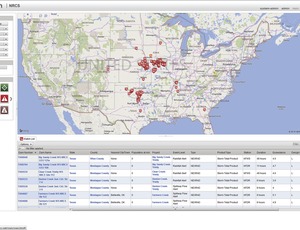

Hartford, Conn.-based USEngineering Solutions unveiled on June 23 a national system to detect incidents that could imperil nearly 12,000 dams across the country. It integrates multiple data streams, including sensors and national seismic and meteorologic data, to issue alerts when heavy storms or earthquakes threaten any dam in the system.
After years of development and testing, DamWatch is live and incorporating all the dams in 47 states that are "federally assisted" by the U. S. Dept. of Agriculture's Natural Resources Conservation Service. The NRCS helps local public entities, such as conservation districts and municipalities, plan, design and construct water-control projects. NRCS then advises the owners and sponsors on management and maintenance.
The system not only distributes alerts via fax, email or text to key parties, it also provides secure, web-based access to extensive design and maintenance data about the threatened facility.
"We're sold," says Larry Caldwell, a watershed specialist with the Oklahoma Conservation Commission and a retired veteran of 41 years with the NRCS. Oklahoma was a test state for the system. "We're monitoring 2,107 dams, and more than half will have reached their 50–year service life this year," Caldwell says. "Most were constructed to control flooding in agricultural areas, but now some of those areas have houses and businesses and industry."
The system has been tested by torrential rains this spring, sending alerts whenever spillways reached capacity and earthen, vegetated, auxiliary spillways were about to run. "We had 190 auxiliary spillways flow in May, and, so far, over 150 in June," Caldwell says.
During May's record rains in the central plains, nearly 1,000 DamWatch alerts helped NRCS personnel focus their response efforts, says NRCS Chief Jason Weller. Service personnel assisted project sponsors in reviewing the condition of hundreds of dams throughout the region.
Caldwell especially likes a feature that lets users create "information tickets" to capture institutional knowledge from the retiring generation of NRCS staffers and project sponsors involved in the original construction of the projects. "These are the little things that make the big difference that will be helpful for the next generation who become responsible for maintenance of the dams," he says. Caldwell says licensing the system, whose fees are borne by the NRCS, costs about $18 per dam per year.



Post a comment to this article
Report Abusive Comment